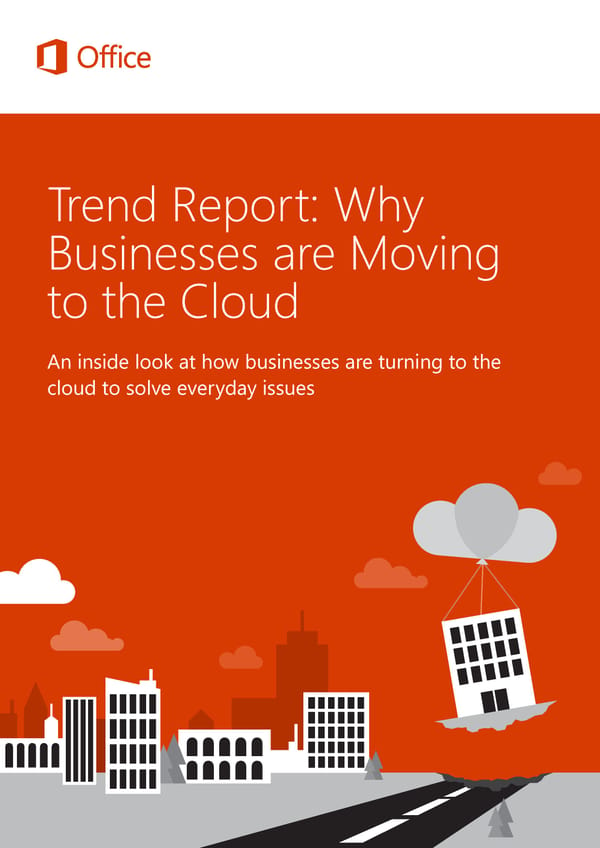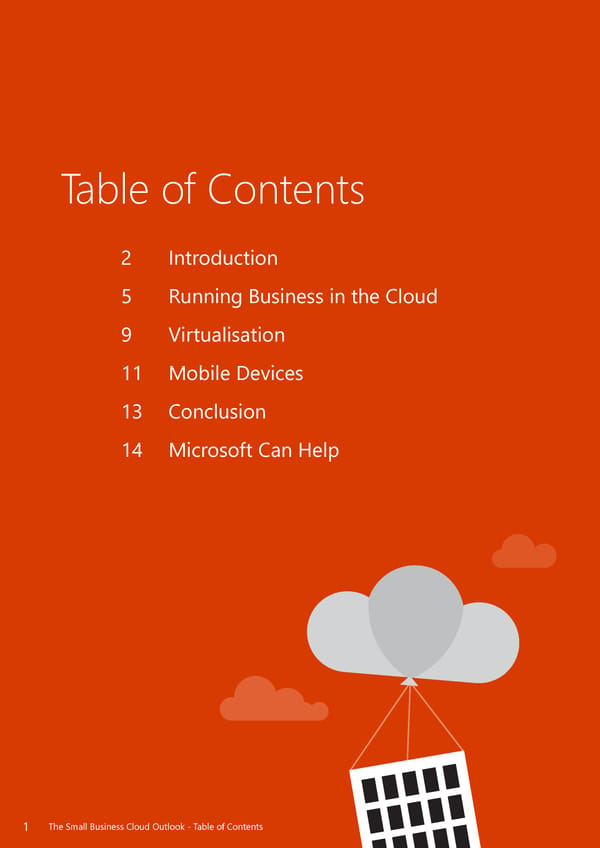Why Businesses Are Moving to the Cloud
An inside look at how businesses are turning to the cloud to solve everyday issues
Trend Report: Why Businesses are Moving to the Cloud An inside look at how businesses are turning to the cloud to solve everyday issues 1

Table of Contents 2 Introduction 5 Running Business in the Cloud 9 Virtualisation 11 Mobile Devices 13 Conclusion 14 Microsoft Can Help 11 The Small Business Cloud Outlook - Table of Contents
Introduction Today’s growing businesses face a tough challenge. They need to provide the same affordable, always-on mobile services that more established businesses offer, but without the economic support enterprises can fall back on. That means IT professionals are constantly looking for creative ways to do more with less: managing teams, stretching budgets, and making the most of infrastructure and applications. To meet the needs of their organisations within those constraints, they’re turning to the cloud. Studies show that large enterprises are making heavier use of cloud-based applications than their smaller counterparts, but that small and mid-sized businesses are catching up fast. While only about 37% of small and mid-sized businesses are using cloud-based apps this year, experts anticipate that number to reach 78% by 2020. They also predict that the US small and mid-sized business cloud computing and services market will grow from $43B to $55B this year.1,2 We took a closer look at how today’s IT professionals are putting cloud solutions to work in their businesses and how they’re starting to shift their IT spend to match. This e-book offers a high- level overview of current cloud and technology usage in growing businesses, including what workloads are shifting first, what’s driving these efforts and how experience is lining up with these expectations. As cloud-based applications and solutions come within reach of businesses of all sizes, IT professionals are finding new ways to reduce costs and boost productivity. Read on to see what your colleagues are discovering. 1 Cloud-based app adoption, looking ahead: 78% 37% 2015 2020 The Small Business Cloud Outlook - Introduction 2
Survey Information To get a clear picture of the current IT landscape, we asked more than 250 IT professionals across the globe to tell us about their companies, industries and budgets. Respondents come from companies with fewer than 250 employees operating in a mix of industries. Their average IT budgets were just over $100,000, and many expect to increase their IT spend in 2016. Key Findings The process of virtualising workloads and moving applications to the cloud is well-accepted among businesses looking for a smart, affordable way to support a workforce using a growing array of mobile devices to work, communicate, collaborate and engage customers. 1 The majority of businesses surveyed have adopted some form of cloud solution or hosted service in an effort to simplify their daily tasks, lower costs and give employees always-on access to information and applications. 2 IT professionals are also virtualising their servers in order to handle IT- related workloads ranging from storage and printing to security. 3 Growing businesses are increasingly using and supporting smartphones, tablets, laptops and other mobile devices within their organisations. These devices are often BYOD and run on a range of operating systems. The Small Business Cloud Outlook - Introduction 3
Companies are looking to move daily business services to the cloud. That change is only possible if they can tailor cloud services to their own operations. 3 Paul Korzeniowski, TechTarget 4
Running Business in the Cloud IT professionals work to provide their colleagues with the tools and services they need, but they’re also tightly focused on keeping costs down. Cloud-based software delivery is becoming the standard for reaching both goals. Roughly three-quarters of the IT professionals surveyed said they’re using some type of cloud or hosted service. The most common cloud services include Web hosting (75%), productivity solutions (55%), email hosting (54%) and content filtering (45%). In addition to simplifying IT management, IT professionals mentioned the need to increase availability (51%) and reduce both IT complexity and costs (45% and 44%). These expectations appear to track with experience: As a result of using a cloud approach, nearly 80% said they’re saving money and seeing more productivity and better security. More specifically, they reported saving 20% on average, as a result of moving hosting services and productivity apps to the cloud. 74% of respondents report their organisations use some type of cloud/hosted service. The Small Business Cloud Outlook - Running Business in the Cloud 5
As a result of using a cloud approach, nearly 80% [of surveyed IT pros] said they’re saving money, seeing more productivity and better security. 6
Most common cloud service adoption Currently use Plan to use in next 6 months No plans to use in next 6 months Web hosting 75% 3% 23% Productivity solutions 55% 13% 32% Email hosting 54% 11% 35% Content filtering 45% 6% 49% Online backup/recovery 37% 17% 46% Infrastructure 30% 12% 57% Industry-specific applications 28% 5% 67% Business support 28% 7% 65% Application hosting 28% 8% 64% 0% 10% 20% 30% 40% 50% 60% 70% 80% 90% 100% The Small Business Cloud Outlook - Running Business in the Cloud 7
Key drivers for moving to a cloud approach To simplify IT management 58% To increase availability/access 51% To reduce IT complexity 45% To reduce IT costs 44% To increase efficiency/productivity 42% To improve support/service 35% 0% 10% 20% 30% 40% 50% 60% 70% 79% of respondents report experiencing cost savings, increased employee productivity and/or improved security as a result of using a cloud approach. On average, respondents report 20% a cost savings of approximately: The Small Business Cloud Outlook - Running Business in the Cloud 8
Virtualisation Another thing many IT professionals have in common is the use of virtualisation technology. More than three-quarters of respondents said their organisations are virtualising their servers. The top workloads involved are IT-related: 83% are using virtual servers to provide IT services such as storage and printing, while 76% report using them to handle internal IT concerns, such as security and inventory management. Companies with virtualised servers may look to cloud solutions as a logical next step, in order to take advantage of the benefits of self-service provisioning and the ability to scale as usage changes. Virtualisation adoption 78% Yes 6% No, but I plan to within 6 months 14% No, and I don’t plan to within 6 months 2% Not sure The Small Business Cloud Outlook - Virtualisation 9
Top workloads running in a virtualised environment Currently run Plan to run in next 6 months No plans to run in next 6 months IT services 83% 9% 9% Internal IT 76% 9% 15% Industry-specific applications 63% 8% 29% Productivity applications 62% 9% 29% Business support 60% 10% 29% Development 42% 5% 53% Content publishing 41% 7% 52% 0% 10% 20% 30% 40% 50% 60% 70% 80% 90% 100% The Small Business Cloud Outlook - Virtualisation 10
Mobile Devices Regardless of size, businesses today are becoming increasingly mobile, with employees traveling more often to meet clients; to work with teams from other offices; or to connect with workers in the field, in different retail locations and more. Studies also show that nearly half of growing 1 companies’ owners now routinely use smartphones to run day-to-day operations. As a result, these companies’ IT professionals are looking for better ways to support mobile employees and provide better access and security from a growing range of devices—and cloud is a gr eat way to do this. IT professionals in our survey said 95% of their organisations support laptops, while 88% support smartphones and 78% support tablets. Based on their feedback, the average small or mid- sized business supports 29 laptops, 38 smartphones and 14 tablets on its network, although organisations in EMEA support considerably more laptops and smartphones than those in North America. Smartphones emerged as the most commonly supported BYOD device across geographies. No single mobile OS platform dominated in the survey; most organisations see a pretty even mix. We were reaching a tipping point with over half of our system users being mobile users. All roads lead to mobile first, and we needed to support it through the cloud. 4 Respondent, Forrester survey The Small Business Cloud Outlook - Mobile Devices 11
Conclusion As cloud applications and capabilities become attainable for businesses of all sizes, IT professionals are using these solutions to make day-to-day work faster, more agile and more secure across their organizations. What’s more, they’re putting their companies in position to realise real benefits: Anywhere, anytime access to the applications and information employees need, with lower total costs and less infrastructure to purchase and maintain. The result is that IT professionals can shift even more of their time, talent and budgets toward delivering big results. When we talk about cloud, it’s no longer a future issue; it’s a present and essential element, addressing real business needs, adding simplicity and security, and helping to accelerate innovation and growth. These benefits can’t be ignored. John Mason, Thoughts on Cloud 5 13
Conclusion As cloud applications and capabilities become attainable for businesses of all sizes, IT professionals are using these solutions to make day-to-day work faster, more agile and more secure across their organizations. What’s more, they’re putting their companies in position to realise real beneits: Anywhere, anytime access to the applications and information employees need, with lower total costs and less infrastructure to purchase and maintain. The result is that IT professionals can shift even more of their time, talent and budgets toward delivering big results. When we talk about cloud, it’s no longer a future issue; it’s a present and essential element, addressing real business needs, adding simplicity and security, and helping to accelerate innovation and growth. These beneits can’t be ignored. John Mason, Thoughts on Cloud 5 13
Microsoft Can Help Microsoft addresses the evolving needs of businesses at all stages of growth with Office 365: Top- of-the-line, familiar tools that make it easy for employees to get the information they need and to work and collaborate effectively on the go. Office 365’s cloud-based delivery model streamlines installation, upgrades, management and security, freeing-up time and making the most of IT budgets. Increase productivity with trusted software like Microsoft Word, Excel, PowerPoint and Outlook—with better features, automatic updates, availability on any OS, and built-in security and compliance. Subscription-based model cost savings are more cost-effective than buying individual licenses. Office 365 also reduces infrastructure costs and eliminates the need for time-consuming implementation, licensing headaches and software support. Automatic upgrades, patches and updates on every device are at no additional cost. Easy-to-use Web-based admin tools simplify IT management and are accessible from anywhere, with services that are always on and always up-to-date. Learn more The Small Business Cloud Outlook - Microsoft Can Help 14
About the survey Microsoft commissioned Spiceworks to conduct an online survey in August 2015 to examine the current state of IT for SMBs. A total of 264 surveys were collected from North America (70%) and EMEA (30%), and from industries including IT services, manufacturing, non-profit, finance, healthcare and construction. All respondents were IT professionals with insight into budgeting practices for their organisations, in roles that range from hands-on administration to high-level management. Their organisations are SMBs with fewer than 250 employees. Of these, 39% came from organisations with 100 to 249 employees, and 61% came from organizations with fewer than 100 employees. References: 1 “Roundup Of Small & Medium Business Cloud Computing Forecasts And Market Estimates, 2015,” Forbes, May 2015. http://www.forbes.com/sites/louiscolumbus/2015/05/04/roundup-of-small- medium-business-cloud-computing-forecasts-and-market-estimates-2015/ 2 “SMB Cloud is an IT priority and an IT reality reaching 96 percent adoption in the US,” techaisle, February 2015. http://techaisle.com/blog/184-smb-cloud-is-an-it-priority-and-an-it-reality-reaching- 96-percent-adoption-in-the-us 3 “Cloud computing technology trends in 2015,” TechTarget, December 2014. http://searchcloudcomputing.techtarget.com/feature/Cloud-computing-technology-trends-in-2015 4 “ROI of Office 365: Forrester Total Economic Impact Summary,” Forrester, 2015. http://www.slideshare. net/whymsft/roi-of-office-365-forrestroioffice365forrestertotaleconomicimpact 5 “Top 5 uses of cloud computing for 2015,” Thoughts on Cloud, April 2015. http://www.thoughtsoncloud.com/2015/04/top-5-uses-of-cloud-computing-for-2015-2/ 15

